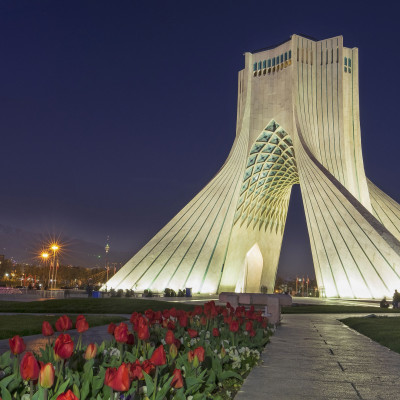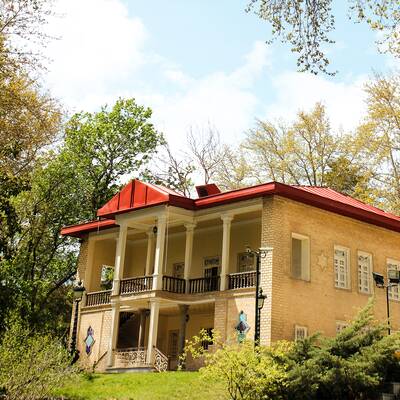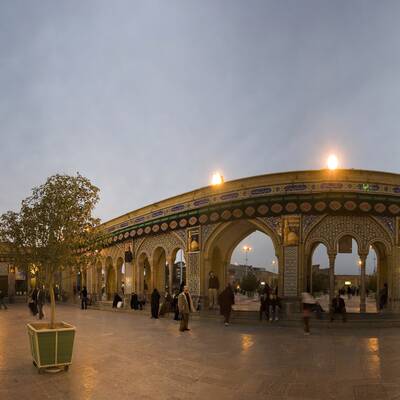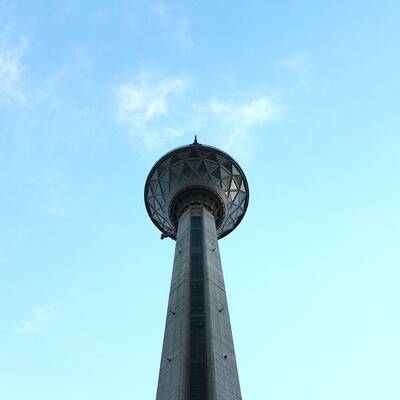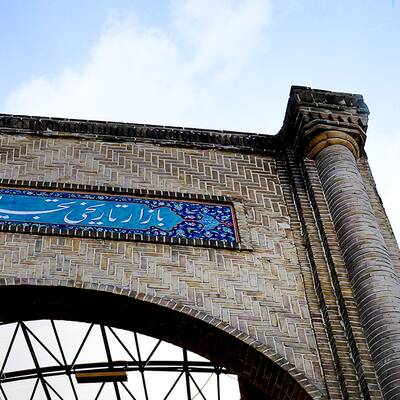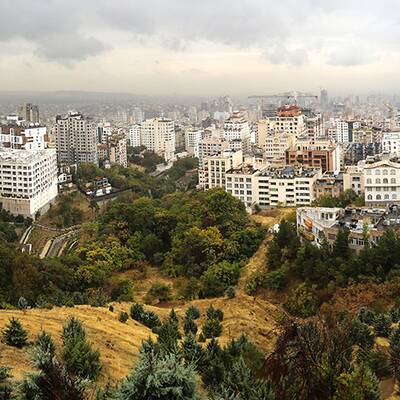Niavaran Historical Garden
Endowed with a fantastic natural and historical beauty, the Cultural-Historic Complex of Niavaran with an area of about 11 hectares is located in the north of Tehran. All monuments in this complex belong to Qajar and Pahlavi Periods.
Qajar Kings at first used this place as their summerhouse. Fathali Shah, the Qajar king, ordered to construct a pleasant garden out of Tehran where has a healthy climate beside the village of “Gordevi” or “Gordebeh". This place was less-extended than nowadays. This garden replaced the reed-bed that was adjacent to the village. The country garden of Fathali Shah that replaced the reed-bed was called Nei (reed) Avaran (growing); it was later entitled Niavaran. A small monument was later built by Mohammad Pahlavi.
After that, Naser al-Din Shah constructed Sahebqaranieh Palace. Ahmad Shahi Mansion was the last monument built by the Qajars. During the reign of Mohammad Reza Pahlavi, some of the monuments were destroyed and the Complex was rebuilt in a modern style to be resided in by the Pahlavi family.
Sahebqaranieh Palace
Sahebqaranieh Mansion (Palace) was built as directed by Naser al-Din Shah in the summer quarters of Niavaran hamlet in 1267 A.H. In the thirtieth year of Naser al-Din Shah’s kingdom the whole complex was called “Sahebqaranieh”.
At the time of Mozaffar ad-Din Shah and Ahmad Shah, Sahebqaranieh Mansion was narrowed down, and at the time of Pahlavi I, in line with the marriage of Mohammad Reza Pahlavi and Fouzieh in 1939, and as directed by Reza Pahlavi, the building was prepared after undergoing some changes for the entertainment of the ceremony guests, but the ceremony was not held in the mansion due to cold weather. Afterward, from 1967 to 1978, Sahebqaranieh Palace served as the office of Mohammad Reza Pahlavi once it underwent major changes. Finally, after the Islamic Revolution, the palace was reconstructed by the experts, masters, and artists and visited by the public under observance of museum decoration regulations in 1998.
Sahebqaranieh Mansion includes two storeys, with the upper one encompassing various parts and rooms such as Documents Room, Military Talks Room, Mirror Hall, Private Negotiations, Ambassadors Lounge, and Midday Resort, and the lower storey called Hoz Khaneh composed of attractive parts such as the Hall of Hoz Khaneh, Korsi Khaneh, Bar, Tea House and a set of the works of art created by the prominent Iranian artists visited by the interested public.
This palace has been closed due to restoration operations.
Ahmad Shahi Mansion
The "Koushk" (in Persian) literally means the palace and any tall building, courtyard, and excellent house and is so-called a building which is through the garden and has a perspective to four sides from inside the building.
This mansion was built in the late Qajar period for Ahmad Shah bungalow in the middle of Niavaran Garden with up to 800 sq.m area in two floors with a gable roof. The main features of this building are decoration and a brick facade used throughout its exterior view, among the others. The bricks are of the molded imprinted type with various designs and pea color.
Ahmad Shahi Mansion was restored in the second Pahlavi period, and some changes were applied to it. Its Furniture and interior decoration were replaced perfectly to use as Reza Pahlavi Residence.
The ground floor of this mansion consists of a hall and a marble basin is placed in the middle of it, surrounded by six rooms and two corridors.
The second floor of the mansion also consists of a central hall and a four-sided veranda. On four sides of the central hall which was used as a music room, Showcase wooden shelves have been installed. Six columns with a thick square cross-section, with a brick body facade, and 26 circular pillars with plaster facades surround the porch.
After the victory of the Islamic Revolution, the use of the bathroom and kitchen of the palace was changed and was devoted to the Venue of periodic exhibitions. It was opened for the first time as a museum in 2000 for the general public.
Niavaran Private Palace
On the northeast of Niavaran Garden lies Niavaran palace measuring approximately 9000 sq.m in area and 14.m in height on two storeys and a half-storey.
The designing architecture of the palace is Eng. Mohsen Foroughi and the supervisory consulting engineers are Abdol-Aziz Farmanfarmaian and Associates Consulting Engineers Co., with “MAP Co.” as the constructing agent.
This palace has served as the residence of Mohammad Reza Pahlavi and his family since 1968.
The place has a quadrilateral plan and interior design inspired by Iranian architecture and is a combination of the pre and post-Islamic art that had implemented by modern technology.
The ceiling is made of aluminum which opens up in the middle electro-mechanically.
The ground floor includes a large hall in which reception rooms, dining rooms, cinema lounge, and sitting rooms lie.
On the second floor lie the bedrooms of Mohammad Reza and Farah, Farah’s makeover room, and their children’s rooms. Moreover, Farah’s office and Leila’s rooms sit on the half-storey.
An invaluable collection of paintings, tapestries, precious Persian carpets and chinaware, and crystals of Sevres and Rosenthal and other factories embellish interiors of the building.
After the victory of the Islamic Revolution, Niavaran Private Palace was opened for the first time as a museum in 1986 for the general public.
Private Library Museum
The Private Library at Niavaran Palace was put up on the northeast of Niavaran Complex in a relatively cozy setting adjacent to the residence of the Pahlavi family in two storeys and one basement with an approximate infrastructural area of 770 sq.m. Ca.1976. This library served as the exclusive library of Farah Pahlavi.
The architectural design was provided by Farmanfarmaian Co. and the brilliant combination of glass and mirror was created by the American artist, Charles Sevigny.
Mass works and paintings by Iranian and foreign artists, including Parviz Tanavoli, Massoud Arabshahi, Bahman Mohasses, Manouchehr Yektai, Mohammad Modabber, Cesar Baldaccini, Diego Giacometti, Arnaldo Pomodoro, and Armand Pierre Fernandez (Arman) garnish the interior space.
The collection of available books in the exclusive library includes 23000 volumes and nearly 16000 titles, comprising Persian writings (cultural, literary, and social compilations, reports and statistics) and foreign works (encyclopedias, specialized art courses, archeology, and nations’ civilization and art resources). The books relating to the history of Persia, French Literature, and the history of painting are more abundant.
One of the features that have distinguished this library from other similar ones, and turned it into a museum, is the existence of books presented or dedicated to this center by Presidents, Leaders, or famous writers of other countries. Among them Parvin E'tesami, Ali-Naqi Vaziri, Manouchehr Atashi, John F.Kennedy, Walt Disney, Jawaharlal Nehru, Roloff Beny, Roman Ghirshman, and the signature of many other eminent people are notable.
The collections of manuscripts are other works of the library. Some of the writers or amanuenses of these manuscripts are Mir Ali Heravi, Ahmad Neirizi, Wisal Shirazi, Mohammad Esfahani, and Mohammad-Taqi Mashhadi.
Relating to size and volume, the smallest book of the collection is The Holy Koran in 5×8cm size, and the biggest one is an Atlas in Latin in 57×82cm.
The oldest book in the foreign section is a Latin one by Josephus Flavius on the history of the Jewish people, published in Paris in 1609. The oldest Persian book is Divan of Hafiz as narrated by Soody, dedicated to Naser al-Din Shah Qajar. This book was published in Leipzig in 1873.
After the victory of the Islamic Revolution, a Private Library was opened as a museum in 2004 for the general public.
Jahan Nama Museum
Jahan Nama museum in Niavaran Palace is a place for displaying the works dedicated to the Pahlavi family or purchased by them in the western part of Sahebqaranieh Palace, reserved in the 1970s for maintenance of these works. In this museum, works from different cultures and civilizations around the world such as Ancient Egypt, potteries from the culture and civilization of the Andes region, stone protons of Buddha from the second century, and pottery containers from Archaeological site in Iran dating back to the 2nd millennium BC and bronze figurines of Lorestan from the 1st and 2nd millennium BC are collected.
In addition, precious works of art by leading and innovating Iranian artists such as Parviz Tanavoli, Hossein Zenderoudi, Manouchehr Yektai, Sohrab Sepehri, Faramarz Pilaram, and Bahman Mohasses together with the works of the famous 20th-century artists such as Picasso, Dali, Renoir, Gauguin, and Braque, who have influenced the history of modern art in the world, get together in the museum.
This museum displays a tangible link in the perfectionism of handicrafts from the ancient eras to date, and this small place shows a world, and one could see the evolution of the humanity taste and feel.
After the victory of the Islamic Revolution, the Jahan Nama Museum was started to work in 1997 for the public.
Automobile Museum
The purposes of constructing the Auto Museum of Niavaran Palace were organizing the complex reservoir, optimizing their maintenance system, exposing automobiles to the public, expanding the museum space of the complex, and attracting more visitors. The construction of this museum was on the top of the agenda in April 2012. The museum was officially put into operation in July 2012 with the endeavors of officials and experts.
Automobile Museum, which used to serve as an auto garage, lies in one story with an area of 200 sq.m., encompasses such works as special automobiles of the Pahlavi family, small motorcycles belonging to the Pahlavi children, and model vehicle.
Auto Museum of Niavaran complex is not only an automobile museum. It takes an approach to protect and introduce the works in terms of initial understanding and historical narration of the complex.
Prominent Automobile
• Rolls Royce Phantom V (1996)
• Rolls Royce Phantom VI (1977)
• Honda ATC 90 motorcycle
• Honda 50 motorcycle
• CHIBI 30430 motorcycle
• LADY MOTOR
Inscriptions Garden
Niavaran Cultural-Historic Complex has organized an exhibition of Written Heritage of the Ancestors (of ours) in collaboration with the Research Institute of Linguistics, Inscriptions, and Texts of Cultural Heritage Research Institute.
In this permanent exhibition 43 moulages of rock inscriptions including Median historical period in Orati, Assyrian and Aramaic scripts and languages belonging to Ahar and Sarab regions, historical periods of Parthia and Sassanian in script and language of ancient Farsi, Akkad, Elamitic, and Aramaic till the end of Sassanian dynasty, and in Crooked Pahlavi script are exhibited. Inscriptions of Shapur and Ardeshir in Naghsh e Rostam, the inscription of Shapur I in Naghsh e Rajab and inscription of Cretier in Naghsh e Rajab are among those inscriptions to exhibit. The exhibition in the east yard of Niavaran Palace inaugurated in May 2008 and is now open to the public.
.jpg)
.jpg)
.jpg)
.jpg)
.jpg)
.jpg)
.jpg)
.jpg)
.jpg)
.jpg)
